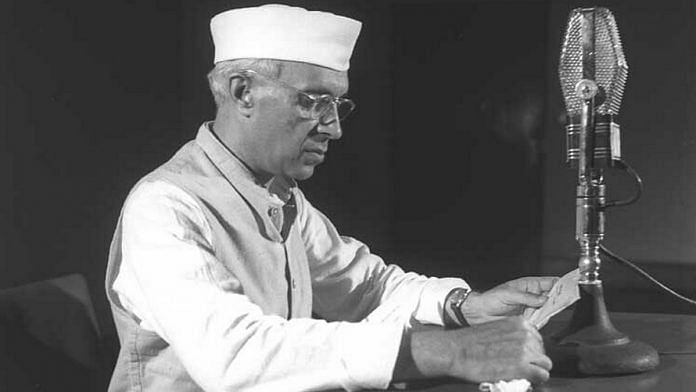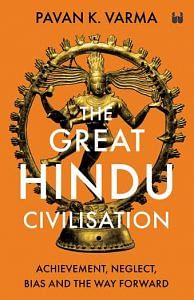
As the first prime minister of independent India, Nehru played an admirable role in leading the young nation, and preventing it from dissembling or—as many thought would happen—from disintegrating. But in one way, Nehru’s view of India’s past was of dismissal and impatience, an impediment to India’s push for progress and modernity. In this sense, he was a product of colonial prejudice, and had internalised—like so many others of the anglicised elite—the superficial but deliberate disdain of Indian culture, and specifically Hindu civilisation. His commitment to India’s freedom was never in doubt, but in spite of himself, he could not but manifest key aspects of the colonial appraisal.
‘It was natural and inevitable that Indian nationalism should resent alien rule,’ he wrote in An Autobiography, ‘and yet it was curious how large numbers of our intelligentsia … accepted, consciously or unconsciously, the British ideology of Empire. … The history and economics and other subjects that were taught in the schools and colleges were written entirely from the British imperial view-point, and laid stress on our numerous failings in the past. … We accepted to some extent this distorted version, and even when we resisted it instinctively we were influenced by it.’ Without doubt, Nehru must not have wanted to be influenced by the colonial critique of India’s past, but because he was extraordinarily perceptive he could understand why this could happen even against one’s will. Thus a yearning for a modernity heavily influenced by Western notions, and a rejection of the past strongly influenced by colonial assessments, became key elements of his world view, and appeared recurrently in his well-intentioned exhortations to the Indian people.
For Nehru, the future of India had to be fashioned unencumbered by the burden of the past. In his writings and speeches, this conviction often reduced itself to a black-and-white representation where, mimicking colonial vocabulary, India’s past became some kind of dark cesspool threatening to hold the country back from progress towards the shining utopia of a rational, industrial and scientific state.
‘India must break with much of her past and not allow it to dominate the present,’ he wrote in his book titled, ironically enough, The Discovery of India. ‘Our lives are encumbered with the dead wood of the past; all that is dead and has served its purpose must go.’ He railed against the ‘dust and dirt of ages’ that had mutilated India’s image, and the ‘excrescences and abortions that have twisted and petrified her spirit, set it in rigid frames and stunted her growth’. Tradition for him was of little value, because it was overlaid by ‘dead thought and ceremonial’, and was irredeemably debilitated by the ‘woeful accumulation of superstitions and degrading custom’. ‘We have to get out,’ he exhorted, ‘of traditional ways of thought and living which, for all the good they must have done in a past age … have ceased to have significance today.’
Also read: How Emergency made it to school textbooks during Congress raj
The interesting thing is that Nehru’s emphatic rejection of the old and traditional did not suppress the tendency—common to the colonised—to romanticise the remote past, and re-invoke it in near mythical terms, as something that was once pure and unsullied but had ‘fallen’ over the ages. Nehru, in fact, admitted that he could not resist the temptation to conjure India as Bharat Mata or Mother India—a very old but beautiful lady, imbued with nobility and greatness, her beauty ‘wrought out from within upon the flesh, the deposit, little cell by cell, of strange thoughts and fantastic reveries and exquisite passions’. The syndrome was familiar and predictable—rejection, in conformity with the critique of the coloniser, and glorification in response to that critique. In the case of Nehru, however, the sentimentalism about the past was definitely subsidiary to his belief that India needed to free itself from its hold. The newly independent nation of which he was the leader must, he was convinced, put on a new garment, for the old was torn and tattered beyond repair.
The reclamation of the wisdoms and refinements of India’s ancient past and Hindu civilisation became a victim of this mindset of the most important person who was at the helm during the formative years of independent India. He had his allies in the anglicised class, most notably in the bureaucracy. The Indian Civil Service set up by the British, where Indians could qualify provided they were role models for the kind of ‘intelligent’ natives who could serve the Empire, was scrapped but was replaced with little or no change in the criteria for qualification, by the Indian Administrative Service. The established members of the elite had a vested interest in perpetuating the old systems in which they were masters. Lip service was paid to India’s glorious past, but little was done to integrate it with the national policy.
For decades after Independence, the educational curriculum in schools and universities continued on colonial lines. Gandhi had warned about the dangers of the colonial education system—designed to entrench the ruler’s perspective—as far back as 1921: ‘It should be remembered that there has been only one system of education before the country for the past fifty years, and only one medium of expression forced on the country. We have, therefore, no data before us as to what we would have been but for the education in the existing schools and colleges. This, however, we know, that India is poorer than fifty years ago. … The system of education is its most defective part. It was conceived and born in error, for the English rulers honestly believed the indigenous system to be worse than useless. It has been nurtured in sin, for the tendency has been to dwarf the Indian body, mind, and soul.’
Thus, our history books made little mention of great Hindu kings like Krishnadevaraya of the Vijayanagara dynasty, or of Raja Raja Chola I. No attempt was made to focus on the political insights of Kautilya’s Arthashastra, or the Shanti Parva of the Mahabharata. Textbooks on Indian history continued to be written mostly by British scholars. Leaders like Shivaji and Maharana Pratap were relegated to the background. There was the constant fear that the teaching of history should not become ‘communal’ by giving disproportionate space to the role of Hindu leaders in opposing Muslim rule. Subjects such as an investigation into the antiquity of ancient India were considered undesirable, as they may lead to Hindu ‘glorification’. The unprecedented renaissance of the bhakti period, lasting six centuries and producing some of the most exquisite devotional poetry, was eclipsed by political chronologies of the Mughal empire. Students learnt about the geography of England before they learnt the basics about their own country. English remained the medium of instruction, especially of elite schools, and schools where this was not the case, or where the means to do so were inadequate, were looked down upon, its products derisively categorised as ‘Hindi-medium types’.
Also read: Ashok Vijaydashmi to Dhola — National archives, central libraries failed Dalit-Bahujan history
Philosophy and metaphysics—the great contributions of Hindu and Indic civilisation—were sidelined, and Western thought dominated the curriculums of philosophy departments. Except for a handful of academics, students were ignorant about the audacity of thought of philosophers like Jaimini, Kapila, Gautama, Kanada, Patanjali and Adi Shankaracharya, to name but a few. Little was done to recall the great cerebral eclecticism of the Hindu period, both in terms of thought and practice. The great achievements of Nalanda hardly figured in teaching courses. Science was taught without almost any reference to the great strides taken in this field by Indian mathematicians and astronomers.
English literature courses were sought after, but there was no systemic way to impart knowledge on Panini’s seminal work on grammar, the Ashtadhyayi, the scores of other works on etymology and linguistic construct and the classics in Sanskrit and other Indian languages. Some schools made a feeble attempt to teach Sanskrit, but the literary corpus of the language was but footnotes in the curriculum. Plays of Shakespeare were taught but Kalidasa ignored. The great epics, Ramayana and Mahabharata, were hardly analysed, and the exquisite lyricism and philosophy of Tulsidasa’s Ramcharitmanas was largely confined to the piety of individual households. So many wisdoms of the past, such as the four ashrams of life, the nishkama karma of the Bhagwad Gita and the remarkably balanced four purusharthas or goals of life—which were secular areas of study—were considered unfit for academic scrutiny.
There was unforgiveable amnesia in the area of culture and creativity. Bharat’s Natya Shastra, perhaps the world’s first comprehensive compendium of the arts, was largely confined to anonymity. India’s seminal contribution on aesthetics, the theory of rasa—again perhaps a pioneer in the world—was little known even to students of specialised schools of art. The curriculum of art colleges even today still remains largely based on Western notions of form and proportion, with no effort to integrate the foundational works on artistic creativity of ancient India. Theatre schools, like the National School of Drama, had curriculums which made but a passing reference to the prodigious work done in this field by Hindu scholars thousands of years ago.
Architecture was taught without even a cursory knowledge of important treatises like the Vastu Shastra. No attempt was made to revert to an indigenous aesthetic idiom that incorporated our own notions of building. A spectacular example of forsaking our own and imitating the West was in the choice of Charles-Edouard Jeanneret (1887–1965), the Swiss–French architect more famously known as Le Corbusier, to design the new city of Chandigarh. The invitation to him provides a dramatic illustration of how, for the colonised, the future and the past are seen as irrevocably opposed, leaving only one choice—a past that must be rejected or a future without the past.
 This excerpt from ‘The Great Hindu Civilisation: Achievement, Neglect, Bias and the Way Forward’ by Pavan K Varma has been published with permission from Westland.
This excerpt from ‘The Great Hindu Civilisation: Achievement, Neglect, Bias and the Way Forward’ by Pavan K Varma has been published with permission from Westland.

COMMENTS